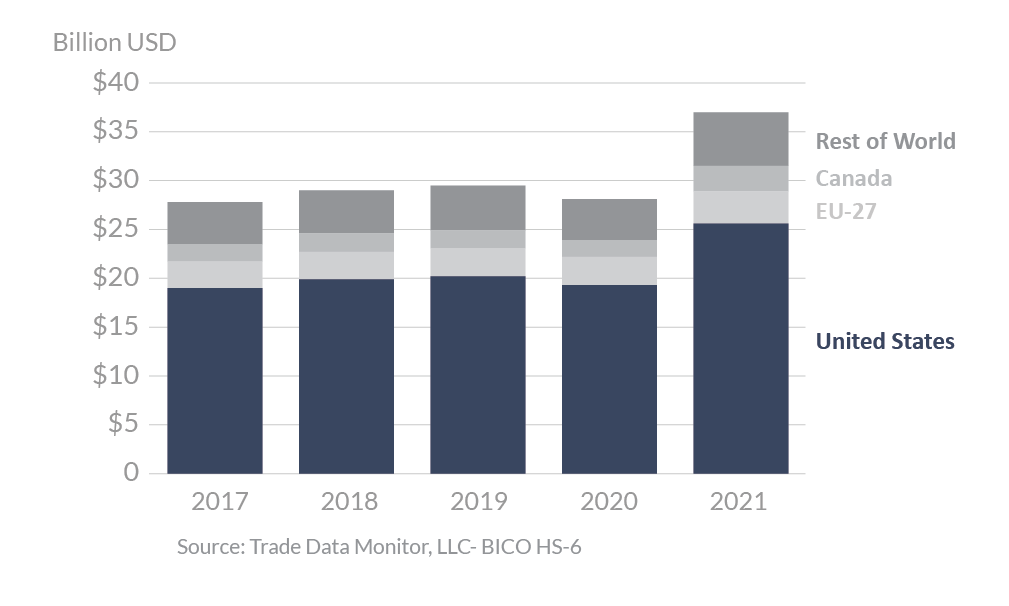
Mexico 2021 Export Highlights
Top 10 U.S. Agricultural Exports to Mexico(values in million USD) |
|||||||
| Commodity | 2017 | 2018 | 2019 | 2020 | 2021 | 2020-2021 % Change | 2017-2021 Average |
| Corn | 2,645 | 3,061 | 2,736 | 2,680 | 4,717 | 76% | 3,168 |
| Soybeans | 1,574 | 1,818 | 1,878 | 1,878 | 2,669 | 42% | 1,963 |
| Dairy Products | 1,293 | 1,375 | 1,526 | 1,401 | 1,787 | 28% | 1,476 |
| Pork & Pork Products | 1,514 | 1,311 | 1,278 | 1,153 | 1,675 | 45% | 1,386 |
| Poultry Meat & Products* | 933 | 956 | 1,077 | 983 | 1,331 | 35% | 1,056 |
| Wheat | 852 | 662 | 812 | 778 | 1,294 | 66% | 880 |
| Beef & Beef Products | 979 | 1,058 | 1,107 | 853 | 1,058 | 24% | 1,011 |
| Soybean Meal | 579 | 665 | 642 | 664 | 841 | 27% | 678 |
| Food Preparations | 520 | 571 | 597 | 582 | 770 | 32% | 608 |
| Fresh Fruit | 570 | 619 | 610 | 546 | 748 | 37% | 619 |
| All Others | 7,357 | 7,207 | 7,136 | 6,818 | 8,628 | 27% | 7,429 |
| Total Exported | 18,816 | 19,303 | 19,399 | 18,336 | 25,518 | 39% | 20,274 |
Source: U.S. Census Bureau Trade Data - BICO HS-10
*Excludes eggs
Highlights
In 2021, U.S. agricultural exports to Mexico surged to a record of $25.5 billion, a 39-percent increase, making Mexico the second-largest export destination for U.S. agricultural products. The United States is Mexico’s top supplier of agricultural goods with a market share of nearly 70 percent. While price increases of bulk commodities are largely responsible for higher overall export values (e.g., soybeans), export volumes of other commodities increased as well. Pork and pork product exports increased by 29 percent by volume (51-percent increase by value), indicating increased consumer demand. Wheat is another commodity where export volume increased significantly, up 34 percent to nearly 4 million metric tons (68-percent increase by value). Demand for imported U.S. dairy products rose as well, up 17 percent by volume (28-percent increase by value) over 2020. Overall, U.S. agricultural exports to Mexico increased across nearly all commodities.
Drivers
- Mexico’s economic growth has been slow in recent years, though it is recovering from the 2020 pandemic downturn. Mexico’s GDP in 2021 was nearly $1.3 trillion, up $200 billion over 2020.
- Overall U.S. agricultural exports to Mexico are buoyed by a variety of products. In 2021, Mexico was the top export market for U.S. dairy, wheat, poultry, dried distiller grains soluble (DDGs), and rice. Mexico is also the second-largest U.S. export market for many other important agricultural commodities including corn, soybean, soybean meal, fresh fruit and vegetables.
- Geographical proximity and close cultural ties contribute to make processed food exports to Mexico a significant portion of overall U.S. agricultural exports, as Mexico ranks as the second-largest market for U.S. food preparation and bakery goods.
- In 2021, Mexico’s recovery from COVID-19 related economic shocks (including decreased international travel and lockdowns affecting the hotel, restaurant, and institutional sector) saw major gains in overall demand for U.S. food and agricultural exports.
- Mexico’s robust and growing livestock and poultry sector, coupled with high grain and soybean prices, also resulted in major value increases for bulk commodities, such as corn and oilseeds. The United States remains Mexico’s food and agricultural provider of choice due to proximity, product quality, price competitiveness, and the integrated and complementary nature of the U.S.–Mexico supply chains.
Mexico’s Agricultural Suppliers

Looking Ahead
Throughout the pandemic, most Mexican consumers adapted their shopping habits when purchasing food and consumer products. Moreover, they cooked more often at home and consumed more supplements and vitamins. E-commerce and delivery apps also saw a big increase in both earnings and usage, as Mexicans were in lockdown for a good period in 2020, and these were the safest ways to purchase food. The Mexican market saw an increase in demand for food but also a small shift, especially from the middle class to certain food: fruits, vegetables, fish, vitamins, and supplements. There is also a (slowly) growing trend for plant-based food, although it could still be considered incipient in Mexico. Young people are looking not only into the products they buy but also into how they are produced and the impact this production has on the environment.
Mexico showed signs of recovery in the hotel, restaurant, and institutional sector with the number of international visitors increasing to 19.4 million, and with a revenue intake of $9.3 billion. These numbers shifted Mexico up in the rankings as the third most visited country in the world, even after the closure of 13,000 restaurants in 2020.
Mexico began taking steps to expand access for U.S. fresh potatoes beyond a 26-km zone along the border in late 2021.
USDA continues to press for a science- and risk-based regulation of products of agricultural biotechnology. On January 1, 2021, a decree entered into force under which existing authorizations “for the use of genetically modified corn grain in the diet of Mexican women and men” will be revoked and new authorizations are prohibited until genetically modified corn grain is completely replaced by January 31, 2024. The United States is pressing Mexico to revoke the decree and ensure that Mexico makes decisions on biotech applications based on science and undertakes and completes its approval procedure for biotech products without undue delay, while maintaining a transparent process.
